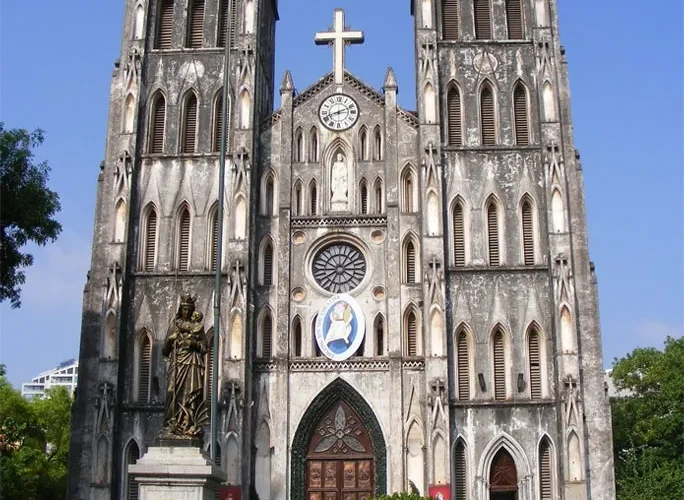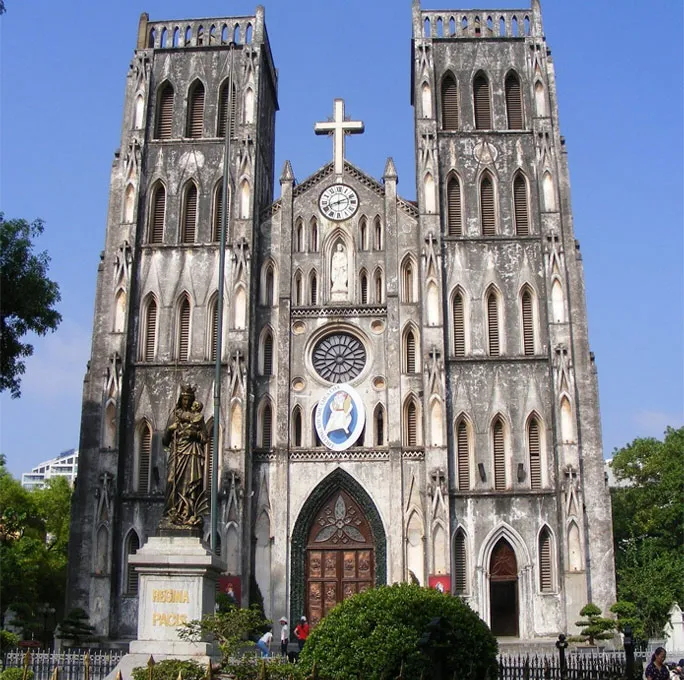
Introduction
St. Joseph’s Cathedral (Vietnamese: Nhà thờ Lớn Hà Nội lit. ’Grand Cathedral of Hanoi’, Nhà thờ Chính tòa Thánh Giuse; French: Cathédrale Saint-Joseph d’Hanoï) is a Catholic church on Nhà Chung Street, in the Hoàn Kiếm District of Hanoi, Vietnam. It is a late 19th-century Gothic Revival (Neo-Gothic style) church that serves as the cathedral of the Roman Catholic Archdiocese of Hanoi. The cathedral is named after Joseph, the patron saint of Vietnam. Construction began in 1884, with an architectural style resembling the Notre Dame de Paris. The church was one of the first structures built by the colonial government of French Indochina when it opened in December 1886. It is the oldest church in Hanoi. Mass is celebrated in the cathedral several times during the day. For Sunday Mass at 6:00 PM, large crowds spill out into the streets. Prayers and hymns are broadcast to the plaza outside; Catholics who are unable to enter the cathedral congregate in the street and listen to hymns.
St. Joseph’s Cathedral (Vietnamese: Nhà thờ Lớn Hà Nội) on Nha Chung (Church) Street, is the oldest church in Hanoi. This was one of the first structures built by the French colonial government in Indochina when it was first opened in December 1886 and completed in 1888. In spite of the long wars that destroying major parts of Hanoi, St Joseph’s Cathedral is still in good condition. Today, it becomes a historical attraction in Hanoi which remains the image of the beauty of the old Hanoi. The Church makes an impression on travelers by its ancient beauty of the bustling capital.
St. Joseph’s Cathedral is an architectural marvel with its elegant neo-gothic architecture built during French colonization. Resembling a lot with Notre Dame de Paris, the facade of this church consists of twin towers. The locals like to call this cathedral ‘The Big Church’ since it serves as the headquarters of the Roman Catholic Archdiocese in Vietnam. The St. Joseph’s Cathedral has beautiful architecture, glass windows and an elaborate altar are among its noteworthy features. It is locally known as ‘The Big Church’ and is the headquarters of the Roman Catholic Archdiocese of Hanoi for more than 4 million Catholics in Vietnam.
St. Joseph’s Cathedral is the oldest church in Hanoi. Having gone through two fierce wars, the church keeps standing peacefully in the bustling city and has witnessed many ups and downs in Hanoi. St. Joseph’s Cathedral is a famous historical site that is always included in any Hanoi travel itinerary. It is one of the first architectural works built by the French colonial government in Indochina. Despite fierce wars devastating nearly all of Hanoi, St Joseph’s Cathedral still miraculously stands intact. It is now packed with hundreds of locals and tourists coming every day to explore its unique architecture and long-lasting history.
St Joseph’s Cathedral, or “The Big Church” familiarly called by the locals, is one of the first structures constructed by French colonists during their expansion in Indochina and still intact in Hanoi after two fierce wars. In spite of fierce fights destroying almost parts of Hanoi, St Joseph’s Cathedral is still in good condition. Today, it becomes a historical attraction in Hanoi which remains the image of the beauty of the old Hanoi and makes an impression on travelers by its ancient beauty inside the bustling capital.
Saint Joseph Cathedral has been located at 40 Nha Chung Street, Hoan Kiem District of Hanoi, Vietnam since 1886 with Neo-Gothic style. The cathedral serves more than 3000 Catholics so that it is also the place that celebrates many religious activities for Catholics in this country. According to some historical documents such as: “La vie de Mgr. Puginier”, “Bong nuoc Ho Guom”, documents of Society of Foreign Missions of Paris, this land formerly belonging to Bao Thien Pagoda, which was built under Ly dynasty. At the end of 18th century, Bao Thien Pagoda was damaged because of war Vietnam – French and the land was transferred to cathedral.
In November 1873, acting in support of the French trader Jean Dupuis, French troops under the command of Lieutenant Francis Garnier captured the Hanoi Citadel, before conquering the rest of the city. A decade passed before the colonists gained full control of Hanoi due to rebel insurgencies.Construction of the cathedral most likely started after this time and it was completed in December 1886, a year before the federation of French Indochina was established as part of its colonial empire.It was built by the French missionary and apostolic vicar of West Tonkin Paul-François Puginier, who obtained permission from the colonial French administration. It was built on the abandoned site of Báo Thiên Pagoda. This location was part of an “administrative center” of Tonkin before the French colonial era. In order to facilitate the construction of the church, the ruins of the pagoda – which was built when the city was founded by the 11th-century Lý dynasty and had collapsed in 1542, never to be repaired – were cleared.The cathedral was consecrated on December 24, 1886.
After the Viet Minh took control of North Vietnam following the Geneva Accords in 1954, the Catholic Church suffered decades of persecution. Priests were arrested, and church property was seized and expropriated.St. Joseph’s Cathedral was not spared; it was closed down until Christmas Eve of 1990, when Mass was permitted to be celebrated there again. In 2008, protests related to religious symbols occurred at the lot next to the cathedral.
Saint Joseph Cathedral is a Catholic cathedral in Hanoi. It was built during the time that bishop Puginier was Apostolic Vicar of Hanoi (1835-1892). Recognizing the development of Economy, Politics, and Culture of Hanoi which will become a center in the future, Bishop Piginier decided to build a church named Saint Joseph following the design of Ke So (So Kien) church but more beautiful. To have finance to build the church, the bishop asked permission for the first lottery, and it was signed by Courbet admiral in 1883. The lottery program gained approximately 17,000 Francs plus someone donated about 5,000 Francs. The Bishop spent approximately 200,000 Francs to build the church which could have enough space for 3,000 people to attend Mass, so he repeatedly wrote a letter to ask for another permission for the second lottery, but his letter was denied. Finally in 1886, Paul Bert, who was the govenor general in Tokin and Annam, understood the financial problem of building the church and allowed the Bishop to open the lottery program to raise money with 11,000 Francs starting with 6,000 dong and plus money of donors. The prices of the lottery program were not money, but were patent art furnitures that were made in Vietnam. They were collected by the Bishop and brought to Europe to exhibit at auctions and museums. Saint Joseph Cathedral of Hanoi was built in four years (1882-1886) following the wise guidance of the Bishop, skillful cooperation of workers, and a French donor. The first Mass was celebrated on December 24th, 1886 when the Cathedral was inaugurated. With the Gothic architecture, Saint Joseph Cathedral of Hanoi marks a period of European technique that entered Vietnam. Saint Joseph Church is 55 meters in length, 33 meters in width, 17 meters in hight, and twin bell towers are 31 meters in hight. It was built by Vietnamese materials that time like earthenware bricks and mortar with pasteboard. Inside the Church, there are curl and wide domes, and on the sanctury there is a wooden screen which was carved with sophisticated and unique wooden motifs of Vietnamese architectural tradition. Especially, the clock with one big bell and four smaller bells were imported with 20,000 Francs. Their sounds everday and each Sunday entered the history and the life of Hanoi inhabitants. For more than 130 years, Saint Joseph Cathedral of Hanoi has become the heart of Hanoi Archdiocese. The life of faith of Catholics always develops and spreads. Saint Joseph Cathedral is not only a unique place in the faith of Hanoi believers but also it is a necessary place for the rest of visitors and pilgrims when they come to visit Hanoi.
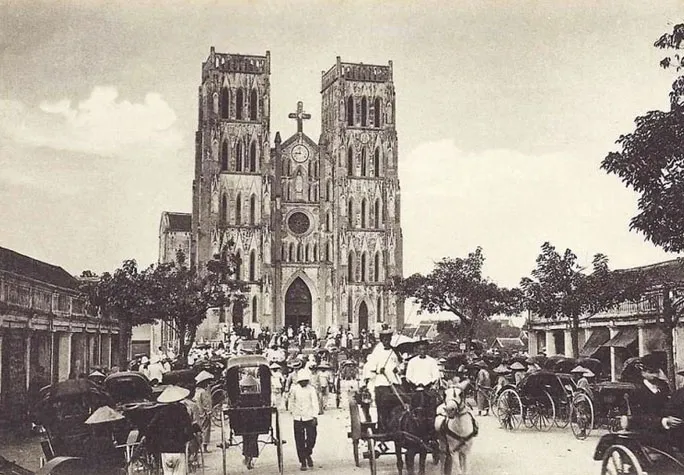
Construction began in 1884, with the architectural style described as resembling Notre Dame de Paris. It is said that St Joseph’s Cathedral has been built on the site of the Bao Thien Pagoda near Hoan Kiem Lake – the biggest and most sacred one, the center of Buddhism in the history of Vietnam during the Ly-Tran Dynasty. In the Le-Nguyen Dynasty, although Buddhism was not as popular as the previous dynasties, it was still the place happening Buddhist rituals praying for peace and prosperity of the country. Until the end of the Nguyen Dynasty, some parts of the pagoda were destroyed to become a market and after the French Colonist came to Hanoi, they demolished completely the pagoda to build the church.
During the French Colonial period, Catholicism was propagated widely and St Joseph’s Cathedral became the center of Catholicism in North Vietnam. There were daily, weekly ceremonies organizing in the church at that time. The church was a place not only welcoming thousands of Catholics in the north of Vietnam but also hiding and catering Vietnamese revolution soldiers. After the retreat of French Colonists from the North of Vietnam in 1954, the cathedral was closed and under the control of the Democratic Republic of Vietnam Government. Not until Christmas in 1990, was it opened again for the Catholics to celebrate.
Architecture of St. Joseph Cathedral Hanoi
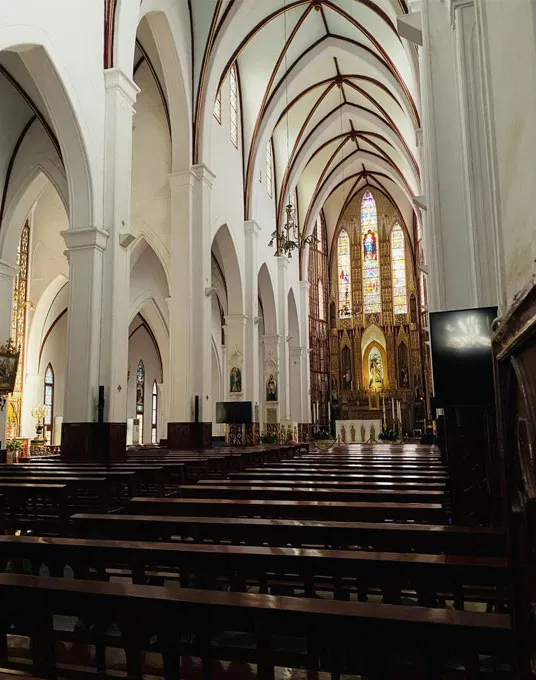
Built in 1887, St. Joseph’s Cathedral boasts neo-Gothic architecture inspired by Notre-Dame de Paris. Its twin bell towers, red-brick façade, and intricate stained glass windows create a striking visual. Inside, the high-vaulted ceilings and religious artwork offer a serene escape from the city’s hustle and bustle. The cathedral was built in a Gothic Revival (Neo-Gothic) style. The twin bell towers have often drawn comparison to those at Notre Dame de Paris; the architects of St. Joseph’s sought to emulate its Parisian counterpart. The exterior walls of the church are made of granite stone slabs.
The cathedral has an ancient and peaceful beauty in the bustling Hanoi. It is 64.5 meters in length and 20.5 meters in width. The facade is made up of two square bell towers with a height of 31.5 meters and a big clock, which resembles the famous Notre-Dame in Paris. In front of the cathedral, there is a copper statue of Mother Maria, and the surroundings are decorated with iron gates, flowers, and trees. St. Joseph’s Cathedral is a classic work of Gothic architecture in Vietnam. Its design features colorful tall glass windows and high domes, and there are pictures of Jesus Christ all around. In addition to the Gothic style, the cathedral’s architecture also has some features of the Vietnamese style. The frame of the building is made of baked clay bricks, red tiles, and pasteboard walls. Worship altars are also decorated with red and golden gilded wood, a common element in traditional Vietnamese temples.
Exterior
Built with stone slabs and in brick with concrete facing, the façade consists of two towers, square in shape, rising to a height of 103 ft (31 m), with each tower fitted with five bells. The cathedral was built in a Gothic Revival (Neo-Gothic) style. The twin bell towers have often drawn comparison to those at Notre Dame de Paris; the architects of St. Joseph’s sought to emulate its Parisian counterpart. The exterior walls of the church are made of granite stone slabs. Over the years, the cathedral’s exterior has become severely worn down due to heavy pollution. In response, the cathedral underwent major renovation works between July 2020 and May 2022, restoring its external appearance and structural integrity.
Interior
Windows are fitted with tall stained glass and have pointed arches. The cathedral’s stained glass windows were produced in France before being transported to Vietnam. The ceiling is rib-vaulted like those seen in medieval Europe. The nave is weathered, while the sanctuary is made of polished gilt-trimmed wood, similar to that of Phát Diệm Cathedral, and has architectural embellishments in the imperial Huế style. A statue of the Virgin Mary is kept in a palanquin according to local custom, which is seen to the left of the nave. A pipe organ designed by the Belgian craftsman Guido Schumacher was installed in the cathedral on 23 November 2022 as part of a cultural exchange project between Itami in Japan and Hasselt in Belgium; the instrument has 1,850 pipes.
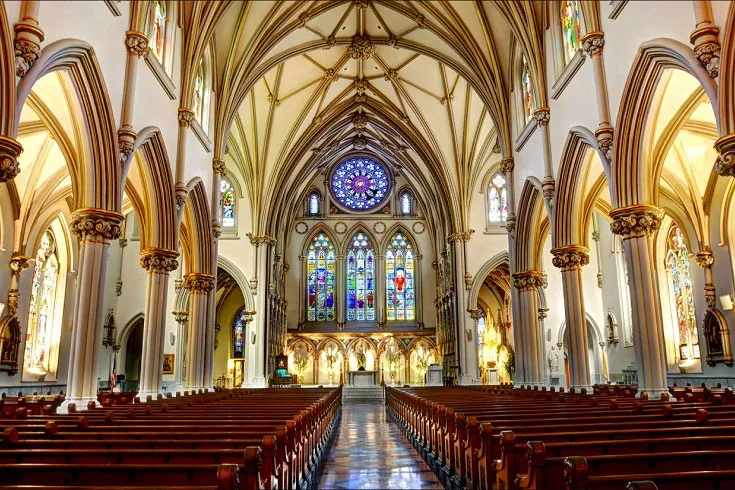
Exterior Design
Outside St. Joseph Cathedral Hanoi
Dimension: St. Joseph Cathedral in Hanoi has a length of 55m, a width of 33m, a high roof of 17m, and two 31m high towers.
Materials: It was built from materials in Vietnam, such as bricks and terracotta roof tiles.
Bell towers: The church stands out with two bell towers on both sides. In the middle of the church is a stone cross creating a highlight; below are a clock and a large statue of St. Joseph.
Clock: The church’s clock is exceptionally large and has three dials displayed at its middle building and two towers. It is the largest tower clock in Vietnam to date. In front of the church square, there is a statue of Mother Maria made of copper, surrounded by flowers and trees.
Interior Design
Inside St. Joseph Cathedral Hanoi
Entry: From the square leading to the church, there is a large door in the middle and two small doors on both sides of the tower.
Doors and windows: In a typical Gothic style, the church has wide, pointed arches and arched doors and windows. These doors and windows are decorated with beautiful and harmonious colored glass paintings of saints, creating a source of natural light inside the church.
Statue: On the left of the interior space is the statue of Our Lady of La Vang, and on the right is the altar of Saint Teresa. In addition, inside the Hanoi cathedral is a grand pipe organ given from Japan on November 23, 2022.
Chancel: The most solemn area of the church is decorated with traditional folk art and intricately carved patterns. In the primary altar area of the chancel, there is a terracotta statue of Saint Joseph holding Jesus Christ, standing over 2 meters high, with saints on both sides.
Pews area: In the middle of the church is the area with pews for parishioners to attend Mass, capable of accommodating up to thousands of people.
Geography
The cathedral is situated west of Hoàn Kiếm Lake, in a small square within the Old Quarter. Located at the end of the Nhà Thờ Street and the corner of Nhà Chung Street, an upscale market area with boutiques and silks popular with tourists, as well as restaurants and small apartment blocks.The cathedral is also the headquarters of Archdiocese of Vietnam; it controls over 480 churches and chapels and 113 parishes, and serves 400,000 Catholics.The cathedral’s main gates are generally only opened during Mass; at other times, entry is allowed through a side door in the compound wall of the diocese, after which a bell can be rung to enter the cathedral proper.
Bell Towers
The most striking feature of St Joseph’s Cathedral is the two bell towers at the front of the building. These towers are 31.5 metres tall and are similar in design to those of Notre-Dame de Paris. Each bell tower has five bells which can be regularly heard ringing out across the city.
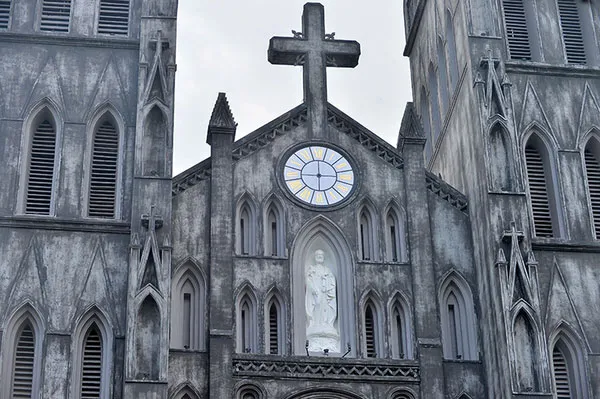
Vaulted Ceilings
Like other medieval style cathedrals and churches, there is a high vaulted ceiling which runs the length of the nave carrying on to the high altar, with wooden ribs installed to support the ceiling
High Altar
The high altar of St Joseph’s Cathedral features several painted images of St Joseph, husband of Mary and carer to the infant Jesus. The choice of St Joseph as patron saint of the cathedral was made to pair the cathedral in Hanoi with the cathedral built a few years earlier in Saigon (Ho Chi Minh City) which was dedicated to St Mary.
Stained Glass Windows
Above the high altar are large stained glass windows which were imported from France by ship. Given the size of the windows, this must have been a difficult and expensive undertaking.
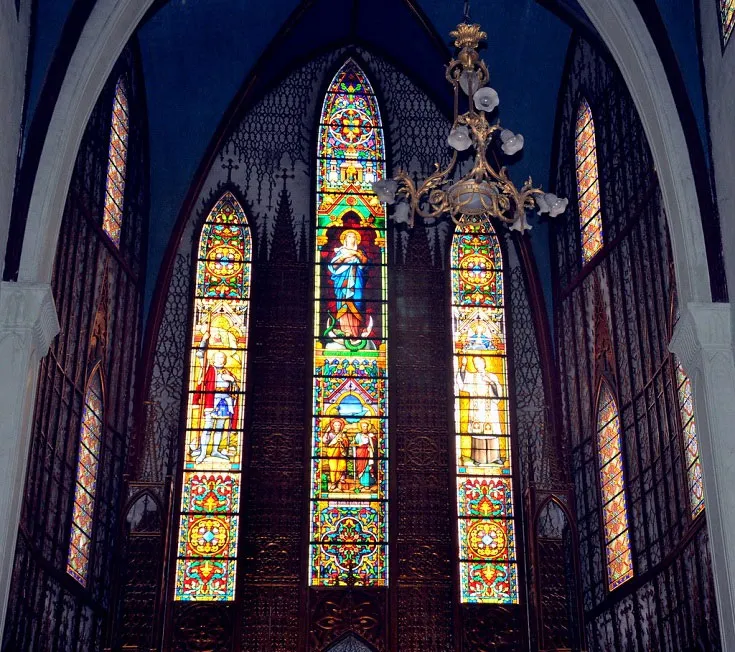
Top 5 Activities to do when Visiting St. Joseph’s Cathedral
1.Visit the Ceremony held in the Cathedral
Visiting the ceremony held in Hanoi Cathedral is an exciting experience that you should try first when visiting this place. This church shows the most the concepts of beliefs and religions of the Catholics through ceremony services, such as weddings or baptisms. If you are non-believers and want to learn more about the unique features of the rituals in a Catholic ceremony, this is an unforgettable experience in life.
Please note that St. Joseph’s Cathedral is free of charge for tourists, and opening and closing hours of the church can vary by day. When visiting the church during the ceremony, you should pay attention to dress politely, discreetly, neatly. Do not speak loudly, shout, and absolutely should not say any discrimination against religious or emotional differences that commit or effect the saints and other Catholics.
2.Celebrating Christmas at St. Joseph’s Cathedral
St. Joseph’s Cathedral will don a colorful coat at Christmas. Bright lights, a big Christmas tree in the square, and various flowers and Christmas wreaths on the cathedral doors together help to warm up the winter atmosphere. Whether you are a Catholic or not, you should stop by the cathedral to immerse yourself in the festive ambiance and make some wishes for yourself and your loved ones. During each Christmas season, St. Joseph’s Cathedral in Hanoi is brightly decorated. People flock to the cathedral to attend mass, hoping for a peaceful and joyful Christmas season. For those who are not believers, they also come here to enjoy the warm and sparkling atmosphere of Christmas with Christmas trees, caves, colorful lights, etc. This will be a memorable memory for your tour in Vietnam.
3.Take Pictures of the Hanoi Cathedral
Whether it’s sunny days, autumn yellow leaves, or winter with the numb wind, the scenery at Hanoi Cathedral is ready to give you the quality background for beautiful photos. Most of the tourists coming to Hanoi seem impossible to ignore this check-in place. Also, we think you do, too. You will have a great time with beautiful pictures to share with your friends when standing in front of this church.
4.Lemon Tea – a Specialty in St Joseph’s Cathedral
Besides the dishes, when it comes to the cathedral, one immediately thinks of lemon tea. Basically, lemon tea at Saint Joseph’s Cathedral is not very different from that at other places in Hanoi. It is a fresh, sour, and sweet drink, but enjoying lemon tea here has become a special culture. Drinking a cup of lemon tea while admiring the space at the cathedral creates a difference for this drink here. It is a pity to miss lemon tea when you have an opportunity to visit St. Joseph’s Cathedral. Just a cup of tea, sitting on the pavement, under the cool green tree canopy, you can gather and chat with friends, enjoy some street foods and see the beauty of the church.
Following the Instructions of the Church
Ensure that your clothes are clean, modest, and polite when you enter the church. Furthermore, bringing food and drink inside is not allowed.
Annual Feast Day
Feast day: 19 March
The annual feast day of The Church of St. Joseph Cathedral Hanoi, Vietnam is celebrated on March 19 each year.
Mass Timing
Monday to Friday: 5:30 AM, 6.15 AM
Saturday: 6:00 PM
Sunday: St. Joseph’s Cathedral offers several additional religious services:
Masses in French: 5:00 am, 7:00 am, 9:00 am, and 11:00 am.
Mass for children: 4:00 pm.
Mass for youth: 6:00 pm and 8:00 pm.
Opening hours
Sunday: from 7:00 am to 11:30 am, from 03:00 pm to 9:00 pm.
From Monday to Saturday: 8am to 11am, from 02:00 pm to 8:00 pm.
Contact Info
40 P. Nhà Chung,
Hàng Trống,
Hoàn Kiếm,
Hà Nội 100000,
Vietnam.
Phone No.
Phone: + 84 243 825 4424
Phone: +84 243 8285 967
Accommodations
Connectivities
Airway
The nearest airport to The Church of St. Joseph Cathedral Hanoi,Vietnam is, Noi Bai International Airport, Phú Minh, Sóc Sơn, Hà Nội, Vietnam, which is just 44 min (27.4 km) via CT Nhật Tân – Nội Bài/Đ. Võ Nguyên Giáp away from the basilica.
Railway
The nearest railway to The Church of St. Joseph Cathedral Hanoi, Vietnam, Hanoi Railway Station, 120 Đ. Lê Duẩn, Văn Miếu, Hoàn Kiếm, Hà Nội, Vietnam, which is just 8 min (1.5 km) via P. Hàng Bông away from the basilica.

